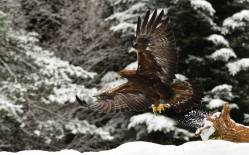Golden eagle - faithful predator
Golden eagle (Latin Aquilachrysaetos), also called fawn, rock, Carpathian, Tatra
or simply profit, is the strongest and most representative representative of the Aquila eagles. It is the second largest predator in Poland after the white-tailed eagle. Ask all your friends who saw the golden eagle in the wild? Few will say - me.
These beautiful and majestic birds are monogamous and live in faithful pairs until the end of their lives. Unfortunately, there are only 8 pairs of golden eagles in the Bieszczady Mountains, of which 6 regularly nest, which is a quarter of the entire Polish population. Due to their timid nature, the golden eagles need vast spaces with forests, meadows and pastures, their breeding territories reach up to 100 square kilometers. They nest at the end of winter. They linger about 20 meters above the ground on tall fir trees, which means that they need old, large trees to survive.
The female eagle usually lays two eggs and incubates them for 45 days, although only one young is brought out of the nest. This is how it is with eagles that the weaker chick is sometimes killed by the stronger one. The law of natural selection is cruel but very effective. The stronger one focuses their parents' care until they become independent at the end of autumn.
The eagle - a symbol of bravery and power
If you meet a golden eagle, you will surely not be indifferent. Their plumage is dark brown with a characteristic yellowish spot on the back of the head and neck. Long wings, a slender silhouette and a rounded long tail make them recognizable to the naked eye. Adult specimens reach a wingspan of up to 250 cm, and the body length of these wonderful predators reaches up to 100 cm. The weight of the female can be as high as 6 kg — males are a bit lighter.
A characteristic feature of eagles is the way of hunting, thanks to their excellent eyesight, they circle in the sky, looking for their prey even from a distance of several kilometers. They're sure to notice you, too. The outstretched and slightly raised wings allow the use of ascending air currents, thanks to which they can glide for a long time without getting tired of flapping their wings. Sometimes the flight of the eagle can be very dynamic: when it dives, its speed can exceed 300 km per hour.
The eagle is a powerful predator that hunts deer, hares, martens, foxes, ravens, herons, ducks and owls. He will not despise a young sheep, domestic cat or hen. The "falcon" makes it possible to see even a slight movement of the head of a rabbit sitting in the grass from a distance of more than two kilometers! The eagle eye has a powerful lens (highly accommodating, that is, the ability to adjust visual acuity to large changes in distance) and five times more photosensitive cells than the human eye. The optic nerve that conducts the impulse from the eye to the brain contains twice as many fibers as the human optic nerve. Perhaps it is worth talking about eagle eyesight?
In exceptional circumstances, eagles feed on carrion. If a bird encounters a "free lunch" left by bears or wolves, it will eat it, sometimes chasing away other smaller scavengers, such as the quite numerous common raven (Corvuscorax).
An endangered species that lives on the San river
In Poland, the golden eagle is subject to complete species protection and is entered into the Polish Red Book of Animals with the status of a very high risk, highly endangered. It must not be killed or scared away, and the places where it sets up its nests are subject to zone protection, which means that, for example, tree felling is not allowed in their vicinity. The world federation of bird protection organizations (BirdLife International) recognizes the golden eagle as a species that requires special care. It is not easy for eagles, each breeding pair needs about 100 square kilometers of hunting area, which is a wild or sparsely populated area. Eagles use one nest for several years, and the old forests are disappearing. Let us make sure that they enjoy our eyes with their predatory majesty for a long time.
A canoe trip through the San Valley is a discovery of the animal world, which is characterized by a great diversity of species, it is also a beautiful lesson in nature conservation. During such a trip, you have the best opportunity to interact with the fauna of Podkarpacie, learn a lot about the importance of endangered species and be an eyewitness to their wonderful life.
fot. Michał Wnuk
















